Bo Han
AdLift: Lifting Adversarial Perturbations to Safeguard 3D Gaussian Splatting Assets Against Instruction-Driven Editing
Dec 08, 2025Abstract:Recent studies have extended diffusion-based instruction-driven 2D image editing pipelines to 3D Gaussian Splatting (3DGS), enabling faithful manipulation of 3DGS assets and greatly advancing 3DGS content creation. However, it also exposes these assets to serious risks of unauthorized editing and malicious tampering. Although imperceptible adversarial perturbations against diffusion models have proven effective for protecting 2D images, applying them to 3DGS encounters two major challenges: view-generalizable protection and balancing invisibility with protection capability. In this work, we propose the first editing safeguard for 3DGS, termed AdLift, which prevents instruction-driven editing across arbitrary views and dimensions by lifting strictly bounded 2D adversarial perturbations into 3D Gaussian-represented safeguard. To ensure both adversarial perturbations effectiveness and invisibility, these safeguard Gaussians are progressively optimized across training views using a tailored Lifted PGD, which first conducts gradient truncation during back-propagation from the editing model at the rendered image and applies projected gradients to strictly constrain the image-level perturbation. Then, the resulting perturbation is backpropagated to the safeguard Gaussian parameters via an image-to-Gaussian fitting operation. We alternate between gradient truncation and image-to-Gaussian fitting, yielding consistent adversarial-based protection performance across different viewpoints and generalizes to novel views. Empirically, qualitative and quantitative results demonstrate that AdLift effectively protects against state-of-the-art instruction-driven 2D image and 3DGS editing.
Physics-Driven Spatiotemporal Modeling for AI-Generated Video Detection
Oct 09, 2025



Abstract:AI-generated videos have achieved near-perfect visual realism (e.g., Sora), urgently necessitating reliable detection mechanisms. However, detecting such videos faces significant challenges in modeling high-dimensional spatiotemporal dynamics and identifying subtle anomalies that violate physical laws. In this paper, we propose a physics-driven AI-generated video detection paradigm based on probability flow conservation principles. Specifically, we propose a statistic called Normalized Spatiotemporal Gradient (NSG), which quantifies the ratio of spatial probability gradients to temporal density changes, explicitly capturing deviations from natural video dynamics. Leveraging pre-trained diffusion models, we develop an NSG estimator through spatial gradients approximation and motion-aware temporal modeling without complex motion decomposition while preserving physical constraints. Building on this, we propose an NSG-based video detection method (NSG-VD) that computes the Maximum Mean Discrepancy (MMD) between NSG features of the test and real videos as a detection metric. Last, we derive an upper bound of NSG feature distances between real and generated videos, proving that generated videos exhibit amplified discrepancies due to distributional shifts. Extensive experiments confirm that NSG-VD outperforms state-of-the-art baselines by 16.00% in Recall and 10.75% in F1-Score, validating the superior performance of NSG-VD. The source code is available at https://github.com/ZSHsh98/NSG-VD.
From Passive to Active Reasoning: Can Large Language Models Ask the Right Questions under Incomplete Information?
Jun 09, 2025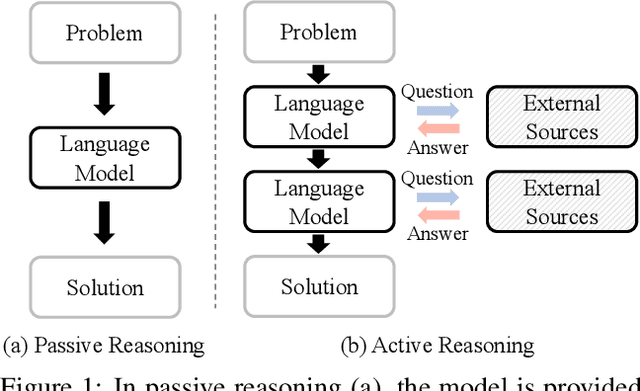
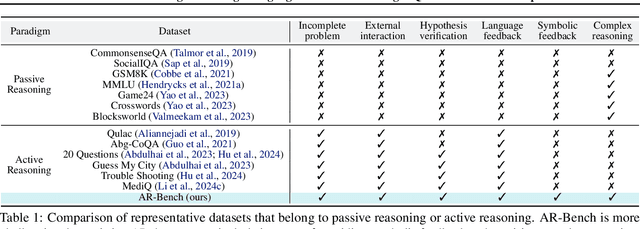


Abstract:While existing benchmarks probe the reasoning abilities of large language models (LLMs) across diverse domains, they predominantly assess passive reasoning, providing models with all the information needed to reach a solution. By contrast, active reasoning-where an LLM must interact with external systems to acquire missing evidence or data-has received little systematic attention. To address this shortfall, we present AR-Bench, a novel benchmark designed explicitly to evaluate an LLM's active reasoning skills. AR-Bench comprises three task families-detective cases, situation puzzles, and guessing numbers-that together simulate real-world, agentic scenarios and measure performance across commonsense, logical, and symbolic reasoning challenges. Empirical evaluation on AR-Bench demonstrates that contemporary LLMs exhibit pronounced difficulties with active reasoning: they frequently fail to acquire or leverage the information needed to solve tasks. This gap highlights a stark divergence between their passive and active reasoning abilities. Moreover, ablation studies indicate that even advanced strategies, such as tree-based searching or post-training approaches, yield only modest gains and fall short of the levels required for real-world deployment. Collectively, these findings highlight the critical need to advance methodology for active reasoning, e.g., incorporating interactive learning, real-time feedback loops, and environment-aware objectives for training. The benchmark is publicly available at: https://github.com/tmlr-group/AR-Bench.
From Debate to Equilibrium: Belief-Driven Multi-Agent LLM Reasoning via Bayesian Nash Equilibrium
Jun 09, 2025Abstract:Multi-agent frameworks can substantially boost the reasoning power of large language models (LLMs), but they typically incur heavy computational costs and lack convergence guarantees. To overcome these challenges, we recast multi-LLM coordination as an incomplete-information game and seek a Bayesian Nash equilibrium (BNE), in which each agent optimally responds to its probabilistic beliefs about the strategies of others. We introduce Efficient Coordination via Nash Equilibrium (ECON), a hierarchical reinforcement-learning paradigm that marries distributed reasoning with centralized final output. Under ECON, each LLM independently selects responses that maximize its expected reward, conditioned on its beliefs about co-agents, without requiring costly inter-agent exchanges. We mathematically prove that ECON attains a markedly tighter regret bound than non-equilibrium multi-agent schemes. Empirically, ECON outperforms existing multi-LLM approaches by 11.2% on average across six benchmarks spanning complex reasoning and planning tasks. Further experiments demonstrate ECON's ability to flexibly incorporate additional models, confirming its scalability and paving the way toward larger, more powerful multi-LLM ensembles. The code is publicly available at: https://github.com/tmlr-group/ECON.
Learning without Isolation: Pathway Protection for Continual Learning
May 24, 2025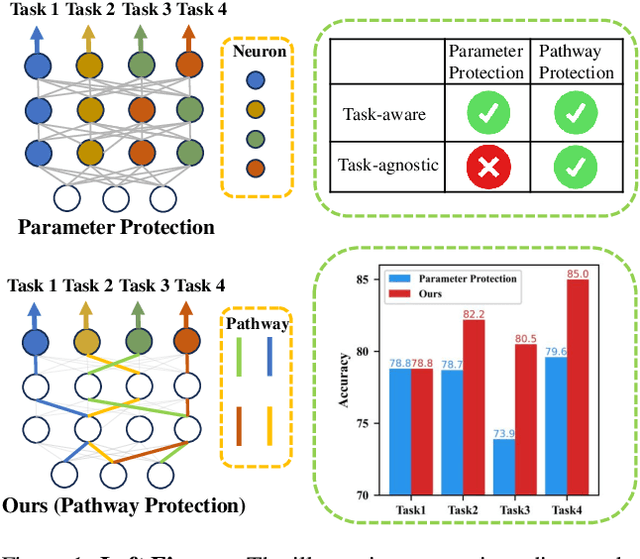
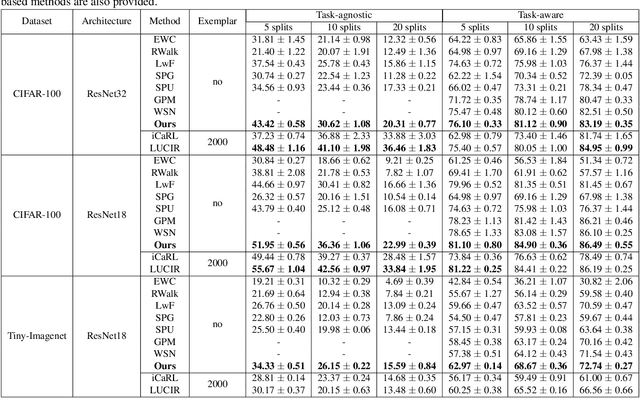
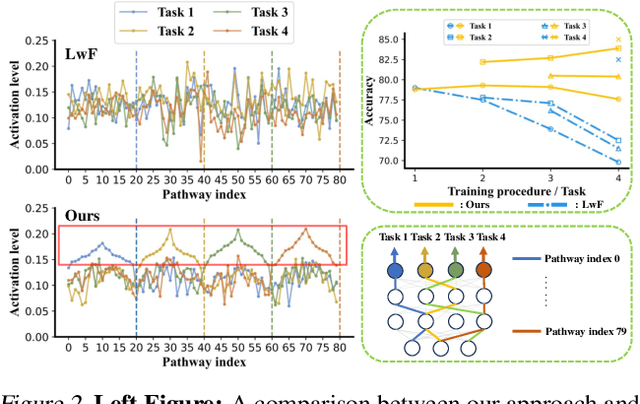
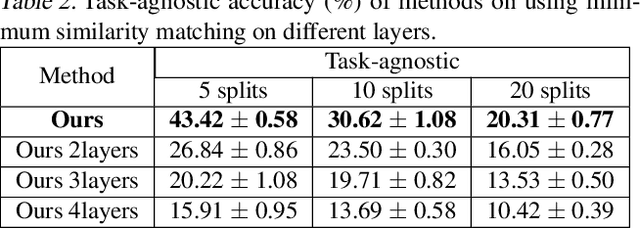
Abstract:Deep networks are prone to catastrophic forgetting during sequential task learning, i.e., losing the knowledge about old tasks upon learning new tasks. To this end, continual learning(CL) has emerged, whose existing methods focus mostly on regulating or protecting the parameters associated with the previous tasks. However, parameter protection is often impractical, since the size of parameters for storing the old-task knowledge increases linearly with the number of tasks, otherwise it is hard to preserve the parameters related to the old-task knowledge. In this work, we bring a dual opinion from neuroscience and physics to CL: in the whole networks, the pathways matter more than the parameters when concerning the knowledge acquired from the old tasks. Following this opinion, we propose a novel CL framework, learning without isolation(LwI), where model fusion is formulated as graph matching and the pathways occupied by the old tasks are protected without being isolated. Thanks to the sparsity of activation channels in a deep network, LwI can adaptively allocate available pathways for a new task, realizing pathway protection and addressing catastrophic forgetting in a parameter-efficient manner. Experiments on popular benchmark datasets demonstrate the superiority of the proposed LwI.
Does Representation Intervention Really Identify Desired Concepts and Elicit Alignment?
May 24, 2025Abstract:Representation intervention aims to locate and modify the representations that encode the underlying concepts in Large Language Models (LLMs) to elicit the aligned and expected behaviors. Despite the empirical success, it has never been examined whether one could locate the faithful concepts for intervention. In this work, we explore the question in safety alignment. If the interventions are faithful, the intervened LLMs should erase the harmful concepts and be robust to both in-distribution adversarial prompts and the out-of-distribution (OOD) jailbreaks. While it is feasible to erase harmful concepts without degrading the benign functionalities of LLMs in linear settings, we show that it is infeasible in the general non-linear setting. To tackle the issue, we propose Concept Concentration (COCA). Instead of identifying the faithful locations to intervene, COCA refractors the training data with an explicit reasoning process, which firstly identifies the potential unsafe concepts and then decides the responses. Essentially, COCA simplifies the decision boundary between harmful and benign representations, enabling more effective linear erasure. Extensive experiments with multiple representation intervention methods and model architectures demonstrate that COCA significantly reduces both in-distribution and OOD jailbreak success rates, and meanwhile maintaining strong performance on regular tasks such as math and code generation.
On the Thinking-Language Modeling Gap in Large Language Models
May 19, 2025


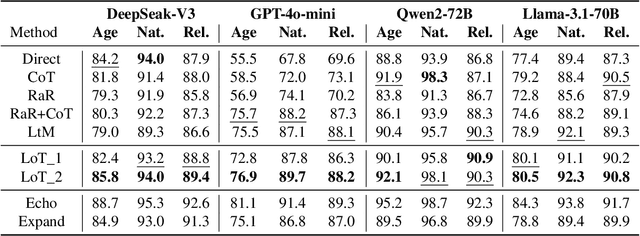
Abstract:System 2 reasoning is one of the defining characteristics of intelligence, which requires slow and logical thinking. Human conducts System 2 reasoning via the language of thoughts that organizes the reasoning process as a causal sequence of mental language, or thoughts. Recently, it has been observed that System 2 reasoning can be elicited from Large Language Models (LLMs) pre-trained on large-scale natural languages. However, in this work, we show that there is a significant gap between the modeling of languages and thoughts. As language is primarily a tool for humans to share knowledge and thinking, modeling human language can easily absorb language biases into LLMs deviated from the chain of thoughts in minds. Furthermore, we show that the biases will mislead the eliciting of "thoughts" in LLMs to focus only on a biased part of the premise. To this end, we propose a new prompt technique termed Language-of-Thoughts (LoT) to demonstrate and alleviate this gap. Instead of directly eliciting the chain of thoughts from partial information, LoT instructs LLMs to adjust the order and token used for the expressions of all the relevant information. We show that the simple strategy significantly reduces the language modeling biases in LLMs and improves the performance of LLMs across a variety of reasoning tasks.
Exploring Criteria of Loss Reweighting to Enhance LLM Unlearning
May 17, 2025Abstract:Loss reweighting has shown significant benefits for machine unlearning with large language models (LLMs). However, their exact functionalities are left unclear and the optimal strategy remains an open question, thus impeding the understanding and improvement of existing methodologies. In this paper, we identify two distinct goals of loss reweighting, namely, Saturation and Importance -- the former indicates that those insufficiently optimized data should be emphasized, while the latter stresses some critical data that are most influential for loss minimization. To study their usefulness, we design specific reweighting strategies for each goal and evaluate their respective effects on unlearning. We conduct extensive empirical analyses on well-established benchmarks, and summarize some important observations as follows: (i) Saturation enhances efficacy more than importance-based reweighting, and their combination can yield additional improvements. (ii) Saturation typically allocates lower weights to data with lower likelihoods, whereas importance-based reweighting does the opposite. (iii) The efficacy of unlearning is also largely influenced by the smoothness and granularity of the weight distributions. Based on these findings, we propose SatImp, a simple reweighting method that combines the advantages of both saturation and importance. Empirical results on extensive datasets validate the efficacy of our method, potentially bridging existing research gaps and indicating directions for future research. Our code is available at https://github.com/Puning97/SatImp-for-LLM-Unlearning.
LONGER: Scaling Up Long Sequence Modeling in Industrial Recommenders
May 07, 2025

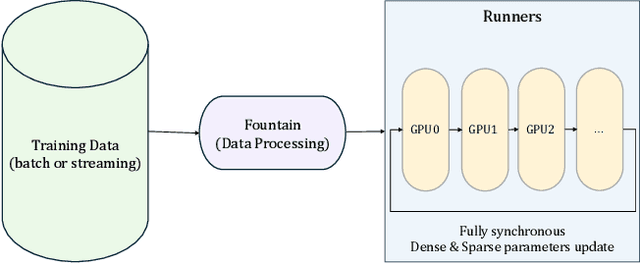
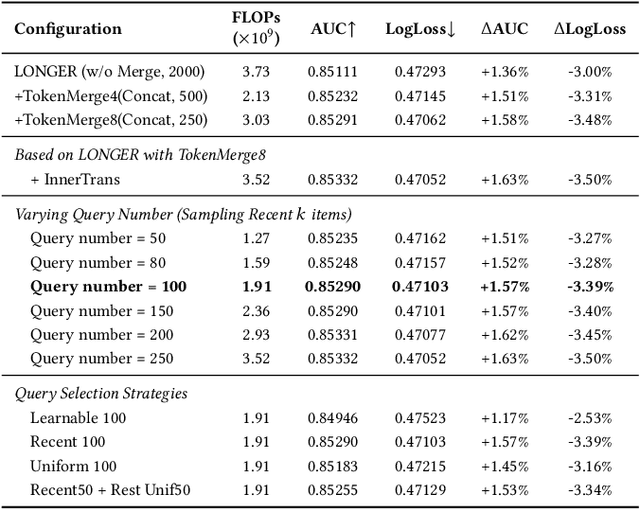
Abstract:Modeling ultra-long user behavior sequences is critical for capturing both long- and short-term preferences in industrial recommender systems. Existing solutions typically rely on two-stage retrieval or indirect modeling paradigms, incuring upstream-downstream inconsistency and computational inefficiency. In this paper, we present LONGER, a Long-sequence Optimized traNsformer for GPU-Efficient Recommenders. LONGER incorporates (i) a global token mechanism for stabilizing attention over long contexts, (ii) a token merge module with lightweight InnerTransformers and hybrid attention strategy to reduce quadratic complexity, and (iii) a series of engineering optimizations, including training with mixed-precision and activation recomputation, KV cache serving, and the fully synchronous model training and serving framework for unified GPU-based dense and sparse parameter updates. LONGER consistently outperforms strong baselines in both offline metrics and online A/B testing in both advertising and e-commerce services at ByteDance, validating its consistent effectiveness and industrial-level scaling laws. Currently, LONGER has been fully deployed at more than 10 influential scenarios at ByteDance, serving billion users.
Landscape of Thoughts: Visualizing the Reasoning Process of Large Language Models
Mar 28, 2025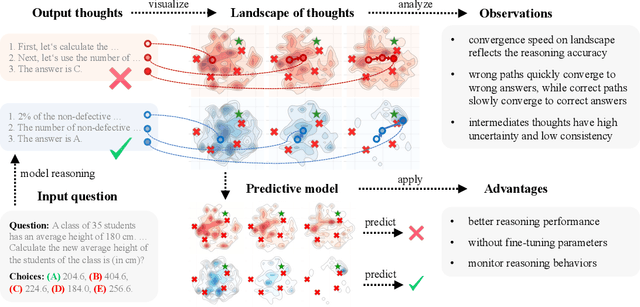



Abstract:Numerous applications of large language models (LLMs) rely on their ability to perform step-by-step reasoning. However, the reasoning behavior of LLMs remains poorly understood, posing challenges to research, development, and safety. To address this gap, we introduce landscape of thoughts-the first visualization tool for users to inspect the reasoning paths of chain-of-thought and its derivatives on any multi-choice dataset. Specifically, we represent the states in a reasoning path as feature vectors that quantify their distances to all answer choices. These features are then visualized in two-dimensional plots using t-SNE. Qualitative and quantitative analysis with the landscape of thoughts effectively distinguishes between strong and weak models, correct and incorrect answers, as well as different reasoning tasks. It also uncovers undesirable reasoning patterns, such as low consistency and high uncertainty. Additionally, users can adapt our tool to a model that predicts the property they observe. We showcase this advantage by adapting our tool to a lightweight verifier that evaluates the correctness of reasoning paths. The code is publicly available at: https://github.com/tmlr-group/landscape-of-thoughts.
 Add to Chrome
Add to Chrome Add to Firefox
Add to Firefox Add to Edge
Add to Edge